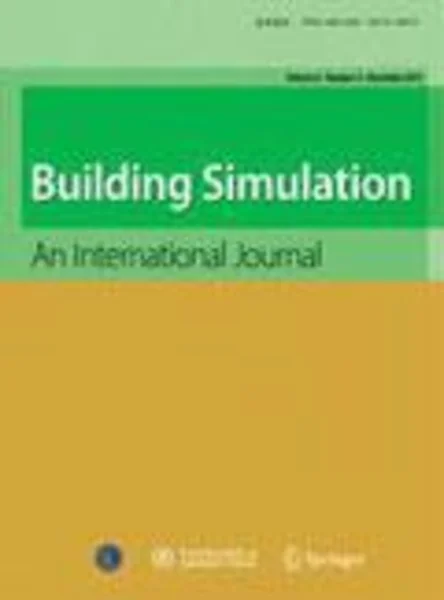-
improving building fabric energy efficiency in hot-humid climates using dynamic insulation
جزئیات بیشتر مقاله- تاریخ ارائه: 1392/07/24
- تاریخ انتشار در تی پی بین: 1392/07/24
- تعداد بازدید: 893
- تعداد پرسش و پاسخ ها: 0
- شماره تماس دبیرخانه رویداد: -
new effective technologies and materials that have the potential to reduce energy demand with excellent energy efficiency and low environmental impact are urgently required in the gulf region. dynamic insulation, which functions by recycling fabric heat loss back to the building, has been established theoretically and proven in pilot projects. it sets the green, low carbon benchmark for thermal insulation in buildings. this paper presents details of the eco-villa, its construction, how the performance of the villa was monitored, and the findings from the initial monitoring phase and the dynamic simulation model (dsm). the villa was tested in two modes, bypass (static) and dynamic. the static u value of the external envelop wall was estimated at 0.24 w/(m2·k) in bypass mode. the theoretical dynamic u value changed from 0.24 to 0.05 w/(m2·k) when the ventilation airflow was varied from 0 to 0.001 m3/(s·m2) (0 to 1 l/(s·m2)), with a further small reduction occurring when the flow rate increased beyond 0.001 m3/(s·m2) (1 l/(s·m2)). the design ventilation rate for the eco-villa was 0.0008 m3/(s·m2) (0.8 l/(s·m2)), which yielded a theoretical dynamic u value of 0.063 w/(m2·k) compared to a measured u value of 0.125 w/(m2·k). the reduction in the fabric conduction gain was found to be 41% whereas the estimate from the dsm was 38%. the results demonstrate the fabric energy efficiency improvements that can be achieved through the use of dynamic insulation.
مقالات جدیدترین رویدادها
-
استفاده از تحلیل اهمیت-عملکرد در ارائه الگوی مدیریت خلاقیت سازمانی و ارائه راهکار جهت بهبود
-
بررسی تاثیر ارزش وجوه نقد مازاد بر ساختار سرمایه شرکت های پذیرفته شده در بورس اوراق بهادار تهران
-
بررسی تأثیر سطح افشای ریسک بر قرارداد بدهی شرکت های پذیرفته شده در بورس اوراق بهادار تهران
-
بررسی تأثیر رتبه بندی اعتباری مبتنی بر مدل امتیاز بازار نوظهور بر نقد شوندگی سهام با تأکید بر خصوصی سازی شرکت ها
-
تأثیر آمیخته بازاریابی پوشاک ایرانی بر تصویر ذهنی مشتری پوشاک ایرانی (هاکوپیان)
-
عوامل خطر ساز بیماری های قلبی- عروقی در بندر بوشهر بر اساس پروژه مونیکای سازمان جهانی بهداشت؛ پروژه قلب سالم خلیج فارس
-
تاثیر تمرین های تقویتی بر شاخص های بیومکانیکی راه رفتن در بیماران همی پارزی مزمن ناشی از سکته مغزی
-
بررسی تاثیر مکش بافتی اولیه بر پتانسیل رمبندگی خاک
-
عملکرد میراگرهای ویسکوز و اصطکاکی در بهبود پاسخ لرزه ای سازه های جداسازی شده ی جرمی
-
تظاهرات دهانی کودکان مبتلا به hiv
مقالات جدیدترین ژورنال ها
-
مدیریت و بررسی افسردگی دانش آموزان دختر مقطع متوسطه دوم در دروان کرونا در شهرستان دزفول
-
مدیریت و بررسی خرد سیاسی در اندیشه ی فردوسی در ادب ایران
-
واکاوی و مدیریت توصیفی قلمدان(جاکلیدی)ضریح در موزه آستان قدس رضوی
-
بررسی تاثیر خلاقیت، دانش و انگیزه کارکنان بر پیشنهادات نوآورانه کارکنان ( مورد مطالعه: هتل های 3 و 4 ستاره استان کرمان)
-
بررسی تاثیر کیفیت سیستم های اطلاعاتی بر تصمیم گیری موفق در شرکتهای تولیدی استان اصفهان (مورد مطالعه: مدیران شرکتهای تولیدی استان اصفهان)
-
بررسی نقش مذهب در تحلیل شخصیت قهرمان داستان در نمایشنامه های برگزیده اول، دوره هشتم تا دهم جشنواره تئاتر رضوی
-
کاوشی در تکنولوژی فکر از منظر اسلام با رویکرد جامعه شناختی
-
وظایف و مسئولیت مدنی شهرداری شهرستان بافت
-
boron nitride nanocone as an adsorbent and senor for ampicillin: a computational study
-
the effect of suffusion phenomenon in the increasing of land subsidence rate




سوال خود را در مورد این مقاله مطرح نمایید :